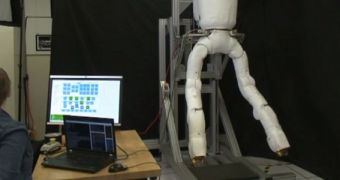Scientists at NASA announce that the Robonaut 2 (R2) robot aboard the International Space Station (ISS) will receive a pair of legs later this month. The machine was constructed to be able to interact with astronauts during sensitive missions, including extra-vehicular activities, and the new legs will help it move around on its own.
At this point, R2 consists of a torso, head, and two arms. NASA experts have developed a pair of legs that Expedition 39 crew members aboard the ISS will attach to the underside of the robot's torso when the components arrive. The legs will be carried into space by an unmanned Dragon cargo spacecraft, developed and launched by Hawthorne, California-based Space Exploration Technologies Corporation.
With the addition of the new legs, R2 will feature an extended leg span of around 2.7 meters (9 feet), which will enable it to move around the ISS. What Mission Control wants to achieve with this machine is the ability to perform repetitive and time-consuming tasks, both inside and outside the space lab, thus allowing human astronauts to focus on more complex and attention-demanding work.
In a statement released last month, NASA R2 developers said that the legs will for now enable R2 to operate safely inside the station. In order for the machine to be allowed outside, an additional series of modifications will have to be conducted on its upper body. The components required for these upgrades will be sent to the ISS on other resupply missions, Space reports.
Each of the robotic legs NASA developed features seven joints, as well as end effectors instead of feet. This will enable the robot to secure itself firmly to the handrails installed outside the station, preventing it from drifting out into space. Cameras and sensors will complement this capability, adding an extra layer of protection for the robotic astronaut and allowing it to move about autonomously.
The $2.5 million (€1.8 million) R2 was launched to the ISS on February 24, 2011, on space shuttle Discovery's last mission, STS-133. The robotic astronaut was first powered up on August 22, 2011, and has been demonstrating its abilities to push buttons, turn knobs, and flip switches ever since. R2 appears to have no problem with operating in microgravity.
“In preparation for future spacewalks, R2 has worked inside the space station with space blankets and other flexible materials, both through ground control and through teleoperation by the on-board crew,” NASA officials said in last month's press release. The robot was developed by the American space agency and General Motors.
Its legs will launch into space aboard the third resupply mission SpaceX conducts for NASA with its Dragon capsule and Falcon 9 delivery system. The two will take off from the Cape Canaveral Air Force Station (CCAFS) in Florida soon, though an exact launch date has not yet been established. The dates targeted by SpaceX right now are April 14, with an April 16 docking to the ISS, or April 18.

 14 DAY TRIAL //
14 DAY TRIAL //